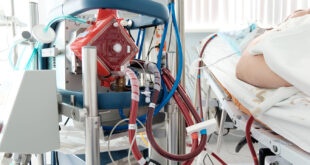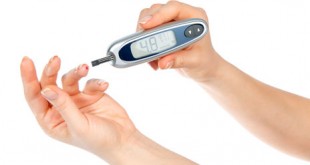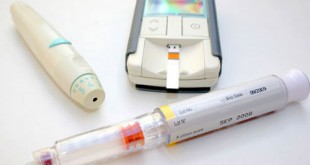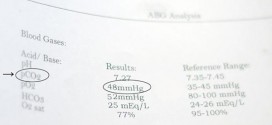Hypophosphatemia

هایپوفسفاتمی به غلظت های پائین تر از حد طبیعی فسفر غیر ارگانیک سرم اطلاق می شود. اگرچه هایپوفسفاتمی اغلب بر کمبود فسفر دلالت دارد ، اما گاهی اوقات تحت شرایطی ایجاد می شود که ذخایر کل فسفر بدن در حد طبیعی هستند . برعکس ، کمبود فسفر به پائین آمدن غیر طبیعی مقادیر فسفر بافتهای غیر چربی بدن گفته می شود که می تواند بدون وجود هایپوفسفاتمی نیز ایجاد گردد.
از جمله علل بروز هایپوفسفاتمی می توان موارد زیر اشاره کرد :
- انتقال فسفر از سرم به داخل سلول ها
- افزایش دفع پتاسیم از راه ادرار
- کاهش جذب پتاسیم از روده ها
- طولانی شدن هایپرونتیلاسیون های شدید
- ترک الکل
- مصرف ناچیز فسفر در رژیم غذایی
- انسفالوپاتی های کبدی
- کتواسیدوز دیابتیک
- سوختگی های وسیع
مقادیر پائین منیزیم و پتاسیم و افزایش ترشح هورمون پاراتیروئید منجر به افزایش دفع فسفر از راه ادرار شده و به بروز هایپوفسفاتمی کمک می نمایند .
- دفع فسفر از راه کلیه ها میتواند در اثر افزایش حاد حجم مایع بدن ، مصرف بازدارنده های کربنیک انهیدراز (استازولامید[دیاموکس])، دیورز اسموتیک و برخی بدخیمی ها صورت گیرد .
- آلکالوز تنفسی به دلیل انتقال فسفر به داخل سلولی منجر به کاهش مقادیر آن می گردد .
- با مصرف آنتی اسیدهای حاوی منیزیم ، کلسیم یا آلبومین اتصالات فسفری بیشتر شده و در نتیجه فسفر دریافت شده از طریق مواد غذایی کمتر از میزان مورد نیاز جهت حفظ کنترل تعادل فسفر خواهد بود. درجه هایپوفسفاتمی ایجاد شده به مقادیر فسفر موجود در رژیم غذایی و دوز آنتی اسید مصرفی بستگی دارد.
- ویتامین D سبب کاهش مقادیر کلسیم و فسفر شده و استئومالاسی (نرمی و شکننده شدن استخوان ها) را بوجود می آورد.
تظاهرات بالینی
بیشتر علائم و نشانه های کمبود فسفر، در اثر کاهش مقادیر ۲ و ۳ دی فسفوگلیسرات ، ATP یا هر دوی آنها ایجاد می شوند . کمبود ATP ، سبب اختلال در منابع انرژی سلولی شده و کمبود دی فسفوگلیسرات آزاد سازی اکسیژن جهت مصرف بافتی را دچار اختلال می گرداند.
دامنه وسیعی از نشانه های عصبی می توانند پدیدار شوند نظیر :
- تحریک پذیری
- خستگی
- تشویش و نگرانی
- ضعف
- بی حسی
- اختلالات حسی
- اختلال در تکلم (دیس آرتری)
- بلع دشوار(دیس فاژی)
- دو بینی (دیپلوپی)
- گیجی
- تشنج و کما
مقادیر پائین دی فسفوگلیسرات ، آزاد سازی اکسیژن را جهت مصرف بافتهای محیطی کاهش داده و منجر به آنوکسی بافتی می گردد. هیپوکسی نیز به نوبه ی خود سرعت تنفس و احتمال وقوع آلکالوز تنفسی را افزایش داده و موجب حرکت فسفر به داخل سلول و بروز هایپوفسفاتمی خواهد شد.
- آنمی همولیتیک می تواند باعث زردی و رنگ پریدگی پوست و ملتحمه شود.
عقیده بر این است که هایپوفسفاتمی فرد را مستعد ابتلا به عفونت می نماید . در حیوانات آزمایشگاهی ، هایپوفسفاتمی با رکود فعالیت های کموتاکتیک ، فاگوسیتیک و باکتریایی گرانولوسیت ها همراه بوده است. با افت مقادیر ATP در بافتهای عضلانی ، عضلات دچار آسیب دیدگی می گردند . تظاهرات بالینی عبارتند از :
- ضعف عضلانی (یا نامحسوس است یا کاملا آشکار و می تواند بر دستجات عضلانی تاثیر گذارد)
- درد عضلات و رابدومیولیز حاد ( تجزیه رشته های عضلانی مختطط )
ضعف عضلات تنفسی تا حد زیادی وضعیت تهویه ای بیمار را دچار اختلال می گرداند. هایپوفسفاتمی قادر است فرد را نسبت به انسولین مقاوم سازد و در نتیجه سبب بروز هایپرگلیسمی شود. از دست رفتن فسفر برای مدت طولانی ، منجر به وقوع خونریزی و کبود شدگی ناشی از اختلال در عملکرد پلاکتها خواهد شد.
- در آنالیز آزمایشگاهی ، مقادیر فسفر سرم در بزرگسالان کمتر از ۲٫۵ میلی گرم / دسی لیتر گزارش می شود.
- حین مرور نتایج آزمایشگاهی ، پرستار باید به خاطر بسپرد که مصرف گلوکز یا انسولین می تواند مقادیر فسفر سرم را اندکی کاهش دهد.
- مقادیر PTH در هایپرپاراتیروئیدیسم افزایش می یابد.
- منیزیم سرم در اثر افزایش دفع ادراری منیزیم ، کاهش پیدا می کند.
- در اثر فعالیت استئوبلاستها ، میزان آلکالین فسفاتاز بالا می رود. بررسی های رادیولوژی با کمک اشعه X تغییرات اسکلتی پدید آمده در استئومالاسی یا ریکتز را نشان می دهد.
هدف پیشگیری از هایپوفسفاتمی است. بیمارانی را که در معرض خطر هایپوفسفاتمی قرار دارند ، باید از نظر مقادیر فسفر سرم به دقت تحت مراقبت قرار داد و قبل از آنکه کمبود فسفر به مراحل شدید خود برسد تدابیر لازم جهت اصلاح آن ها را آغاز نمود. به محلول های تزریقی باید مقادیر کافی فسفر افزوده شود ، همچنین به میزان فسفر موجود در محلول های غذایی که از راه لوله مورد مصرف بیمار قرار می گیرند نیز باید دقت و توجه داشت.
هایپوفسفاتمی های شدید خطرناک بوده و نیازمند مراقبت سریع و به موقع می باشند. اصلاح مقادیر فسفر از طریق روش های تهاجمی وریدی ، معمولا به بیمارانی محدود می شود که مقادیر فسفر سرم آنها به پائین تر از ۱ میلی گرم/ دسی لیتر رسیده و یا دستگاه گوارش قادر به انجام عملکردهای خود نمی باشد.
تتانی ناشی از کاهش کلسیم سرم و کلسیفیکاسیون بافتی ناشی از هایپرفسفاتمی ( در بافتهایی نظیر بافت های قلبی، عروق خونی، ریه ها، کلیه ها و چشم ها ).
- فرآورده های IV فسفر به اشکال فسفات سدیم یا فسفات پتاسیم موجود می باشند.
سرعت تزریق فسفر نباید از ۱۰ میلی اکی والان/ ساعت فراتر رود و از ناحیه تزریق باید به دقت مراقبت شود چون ارتشاح مواد سبب نسوج مرده و نکروز بافتی می گردند. در وضعیت های نه چندان حاد ، معمولا جایگزین نمودن فسفرهای خوراکی ، کافی به نظر می رسد.
مداخلات پرستاری
پرستاران ، بیماران در معرض خطر هایپوفسفاتمی را شناسایی کرده و آنها را تحت مراقبت دقیق قرار می دهند.
از آنجا که مصرف کالری زیاد در تغذیه وریدی بیمارانی که مبتلا به سوء تغذیه هستند خطرناک می باشد ، به همین دلیل باید اقدامات پیشگیری کننده را که شامل استفاده تدریجی از محلول های غذایی است به عمل آورد تا از انتقال سریع فسفر به داخل سلول جلوگیری گردد.
- از بیمارانی که وجود هایپوفسفاتمی در آنها تایید شده باید مراقبت دقیق به عمل آید تا از بروز عفونت پیشگیری شود ، چون هایپوفسفاتمی می تواند سبب ایجاد تغییراتی در گرانولیست ها گردد .
- در بیمارانی که نیازمند اصلاح مقادیر فسفر از دست رفته هستند ، پرستار باید مرتب میزان فسفر سرم را کنترل نماید و علائم زودرس هایپوفسفاتمی را ثبت و گزارش کند ( تشویش و نگرانی ، گیجی ، تغییر در سطح هوشیاری ) .
- اگر بیمار هایپوفسفاتمی را به صورت خفیف تجربه کرده است باید به مصرف مواد غذایی مانند شیر و فرآورده های آن ، ارگانهای حیاتی ، دانه های مغزدار و آجیل ، ماهی ، انواع گوشت پرندگان و غلات سبوس دار تشویق گردد .
- در صورت هایپوفسفاتمی شدید تر ممکن است مکمل هایی نظیر کپسول نوترافاس (۲۵۰ میلی گرم فسفر/ کپسول) یا فلیتز فسفوسودا (۸۱۵ میلی گرم فسفر/۵ میلی لیتر) تجویز گردد.
Hypophosphatemia

Hypophosphatemia occurs when the serum phosphorus level falls below 2.5 mg/dl (or 1.8 mEq/L). Although this condition generally indicates a deficiency of phosphorus, it can occur under various circumstances when total body phosphorus stores are normal. Severe hypophosphatemia occurs when serum phosphorus levels are less than 1 mg/dl and the body can’t support its energy needs. The condition may lead to organ failure.
Elderly patients are particularly at risk for altered electrolyte levels for two main reasons. First, they have a lower ratio of lean body weight to total body weight, which places them at risk for water deficit. Second, their thirst response is diminished and their renal function decreased, which makes maintaining electrolyte balance more difficult. Age-related renal changes include changes in renal blood flow and glomerular filtration rate.
Medications can also alter electrolyte levels by affecting the absorption of phosphate. So make sure you ask elderly patients if they’re using such over-the-counter medications as antacids, laxatives, herbs, and teas.
How it happens
Three underlying mechanisms can lead to hypophosphatemia:
- a shift of phosphorus from extracellular fluid to intracellular fluid
- a decrease in intestinal absorption of phosphorus
- an increased loss of phosphorus through the kidneys.
Some causes of hypophosphatemia may involve more than one mechanism. Several factors may cause phosphorus to shift from extracellular fluid into the cell. Here are the most common causes.
- hyperventilation
- Sugar high
- Failure to add
- Abnormal absorption
Although the mechanism that prompts respiratory alkalosis to induce hypophosphatemia is unknown, the response is a shift of phosphorus into the cells and a resulting decrease in serum phosphorus levels.
Because vitamin D contributes to intestinal absorption of phosphorus, inadequate vitamin D intake or synthesis can inhibit phosphorus absorption. Chronic diarrhea or laxative abuse can also result in increased GI loss of phosphorus. Decreased dietary intake rarely causes hypophosphatemia because phosphate is found in most foods.
Drugs associated with hypophosphatemia
The following drugs are commonly associated with hypophosphatemia :
- acetazolamide
- thiazide diuretics (chlorothiazide and hydrochlorothiazide)
- loop diuretics (bumetanide and furosemide)
- other diuretics
- antacids, such as aluminum carbonate, aluminum hydroxide, calcium carbonate, and magnesium oxide
- insulin
- laxatives.

Diuretic use is the most common cause of phosphorus loss through the kidneys. Thiazides, loop diuretics, and acetazolamide are the diuretics that most commonly cause hypophosphatemia.
The second most common cause is diabetic ketoacidosis (DKA) in diabetic patients who have poorly controlled blood glucose levels. In DKA, high glucose levels induce an osmotic diuresis. This results in a significant loss of phosphorus from the kidneys. Ethanol affects phosphorus reabsorption in the kidneys so that more phosphorus is excreted in urine.
A buildup of PTH, which occurs with hyperparathyroidism and hypocalcemia, also leads to hypophosphatemia because PTH stimulates the kidneys to excrete phosphate.
Finally, hypophosphatemia occurs in patients who have extensive burns. Although the mechanism is unclear, the condition seems to occur in response to the extensive diuresis of salt and water that typically occurs during the first 2 to 4 days after a burn injury. Respiratory alkalosis and carbohydrate administration may also play a role here.
What to look for
Mild to moderate hypophosphatemia doesn’t usually cause symptoms. Noticeable effects of hypophosphatemia typically occur only in severe cases. The characteristics of severe hypophosphatemia are apparent in many organ systems. Signs and symptoms may develop acutely because of rapid decreases in phosphorus or gradually as the result of slow, chronic decreases in phosphorus.
Hypophosphatemia affects the musculoskeletal, central nervous, cardiac, and hematologic systems. Because phosphorus is required to make high-energy ATP, many of the signs and symptoms of hypophosphatemia are related to low energy stores.
With hypophosphatemia, muscle weakness is the most common symptom. Other symptoms may include diplopia (double vision), malaise, and anorexia. The patient may experience a weakened hand grasp, slurred speech, or dysphagia. He also may develop myalgia (tenderness or pain in the muscles).
- Respiratory failure may result from weakened respiratory muscles and poor contractility of the diaphragm.
- Respirations may appear shallow and ineffective.
- In later stages, the patient may be cyanotic.
- Keep in mind that it may be difficult to wean a mechanically ventilated patient with hypophosphatemia from the ventilator.
With severe hypophosphatemia, rhabdomyolysis (skeletal muscle destruction) can occur with altered muscle cell activity. Muscle enzymes such as creatine kinase are released from the cells into the extracellular fluid. Loss of bone density, osteomalacia (softening of the bones), and bone pain may also occur with prolonged hypophosphatemia. Fractures can result.

Logical neurologic effects
Without enough phosphorus, the body can’t make enough ATP, a cornerstone of energy metabolism. As a result, central nervous system cells can malfunction, causing paresthesia, irritability, apprehension, memory loss, and confusion. The neurologic effects of hypophosphatemia may progress to seizures or coma.
When the heart isn’t hardy
The heart’s contractility decreases because of low energy stores of ATP. As a result, the patient may develop hypotension and low cardiac output. Severe hypophosphatemia may lead to cardiomyopathy, which treatment can reverse.
Oxygen delivery drop-off
A drop in production of 2,3-DPG causes a decrease in oxygen delivery to tissues. Because hemoglobin has a stronger affinity for oxygen than for other gases, oxygen is less likely to be given up to the tissues as it circulates through the body. As a result, less oxygen is delivered to the myocardium, which can cause chest pain.
- Hypophosphatemia may also cause hemolytic anemia because of changes in the structure and function of RBCs.
- Patients with hypophosphatemia are more susceptible to infection because of the effect of low levels of ATP in WBCs.
- Lack of ATP results in a decreased functioning of leukocytes.
- Chronic hypophosphatemia also affects platelet function, resulting in bruising and bleeding, particularly mild GI bleeding.
What tests show
These diagnostic test results may indicate hypophosphatemia or a related condition:
- serum phosphorus level of less than 2.5 mg/dl (or 1.8 mEq/L); severe hypophosphatemia, less than 1 mg/dl
- elevated creatine kinase level if rhabdomyolysis is present
- X-ray studies that reveal the skeletal changes typical of osteomalacia or bone fractures
- abnormal electrolytes (decreased magnesium levels and increased calcium levels).
When dietary changes aren’t working
If your patient’s phosphorus-rich diet hasn’t raised serum phosphorus levels as you had hoped, it’s time to ask these questions:
- Is a GI problem making phosphorus digestion difficult?
- Is your patient using a phosphate-binding antacid?
- Is your patient abusing alcohol?
- Is your patient using a thiazide diuretic?
- Is your patient complying with the treatment regimen for diabetes?
How it’s treated
Treatment varies with the severity and cause of the condition. It includes treating the underlying cause and correcting the imbalance with phosphorus replacement and a high-phosphorus diet. The route of replacement therapy depends on the severity of the imbalance.
- Milder measures
- Sterner steps
Treatment for mild-to-moderate hypophosphatemia includes a diet high in phosphorus-rich foods, such as eggs, nuts, whole grains, organ meats, fish, poultry, and milk products. However, if calcium is contraindicated or the patient can’t tolerate milk, he should instead receive oral phosphorus supplements. Oral supplements include Neutra-Phos and Neutra-Phos-K and can be used for moderate hypophosphatemia. Dosage limitations are related to the adverse effects, most notably nausea and diarrhea.
For patients with severe hypophosphatemia or a nonfunctioning GI tract , I.V. phosphorus replacement is the recommended choice. Two preparations are used: I.V. potassium phosphate and I.V. sodium phosphate.
Dosage is guided by the patient’s response to treatment and serum phosphorus levels. Potassium phosphate requires slow administration (no more than 10 mEq/hour). Adverse effects of I.V. replacement for hypophosphatemia include hyperphosphatemia and hypocalcemia.
If your patient begins total parenteral nutrition or is otherwise at risk for developing hypophosphatemia, monitor him for signs and symptoms of this imbalance. If the patient has already developed hypophosphatemia, your nursing care should focus on careful monitoring, safety measures, and interventions to restore normal serum phosphorus levels. Alert the practitioner to any changes in the patient’s condition and take these other actions:
- Monitor vital signs. Remember, hypophosphatemia can lead to respiratory failure, low cardiac output, confusion, seizures, or coma.
- Assess the patient’s level of consciousness and neurologic status each time you check his vital signs. Document your observations and the patient’s neurologic status on a flow sheet so changes can be noted immediately.
- Monitor the rate and depth of respirations, especially if the patient has severe hypophosphatemia. Report signs of hypoxia, such as confusion, restlessness, increased respiratory rate and, in later stages, cyanosis. If possible, take steps to prevent hyperventilation, because it worsens respiratory alkalosis and can lower phosphorus levels. Follow arterial blood gas results and pulse oximetry levels to monitor the effectiveness of ventilation. If the patient is on a ventilator, wean him off slowly.
- Monitor the patient for evidence of heart failure related to reduced myocardial functioning. Signs and symptoms include crackles, shortness of breath, decreased blood pressure, and elevated heart rate.
- Monitor the patient’s temperature at least every 4 hours. Check WBC counts. Follow strict sterile technique in changing dressings. Report signs of infection.
- Assess the patient frequently for evidence of decreasing muscle strength, such as weak hand grasps or slurred speech, and document your findings regularly.
- Administer prescribed phosphorus supplements. Keep in mind that oral supplements may cause diarrhea. To improve their taste, mix them with juice. Vitamin D may also be ordered with the oral phosphate supplements to increase absorption.
- Insert an I.V. line as ordered, and keep it patent. Infuse phosphorus solutions slowly, using an infusion device to control the rate. During infusions, watch for signs of hypocalcemia, hyperphosphatemia, and I.V. infiltration; potassium phosphate can cause tissue sloughing and necrosis. Monitor serum phosphate levels every 6 hours.
- Administer an analgesic, if ordered.
- If ordered, make sure the patient maintains bed rest for safety. Keep the bed in its lowest position, with the wheels locked and the side rails raised. If the patient is at risk for seizures, pad the side rails and keep an artificial airway at the patient’s bedside.
- Orient the patient as needed. Keep clocks, calendars, and familiar personal objects within his sight.
- Inform the patient and his family that confusion caused by a low phosphorus level is only temporary and will likely decrease with therapy.
- Record the patient’s fluid intake and output.
- Closely monitor serum electrolyte levels, especially calcium and phosphorus levels, as well as other pertinent laboratory test results. Report abnormalities.
- Assist the patient with ambulation and activities of daily living, if needed, and keep essential objects near the patient to prevent accidents.

- Teaching points
- Chart smart
Teaching about hypophosphatemia
When teaching a patient with hypophosphatemia, be sure to cover the following topics and then evaluate your patient’s learning:
- description of hypophosphatemia and its risk factors, prevention, and treatment
- medications ordered
- need to consult with a dietitian
- need for a highphosphorus diet (1 qt of cow’s milk per day provides the average amount of phosphate required)
- avoidance of phosphate-binding antacids
- warning signs and symptoms and when to report them
- need to maintain follow-up appointments.
Documenting hypophosphatemia
If your patient has hypophosphatemia, make sure you document the following information:
- vital signs
- neurologic status, including level of consciousness, restlessness, and apprehension
- muscle strength
- respiratory assessment
- serum electrolyte levels and other pertinent laboratory data
- notification of the practitioner
- I.V. therapy, including condition of I.V. site, medication, dose, and the patient’s response
- seizures, if any
- your interventions and the patient’s response
- safety measures to protect the patient
- patient teaching.
منبع : برونر و سودارث ( ویرایش یازدهم ۲۰۰۸ ) درد ، الکترولیت ، شوک ، سرطان ، مراقبت پایان عمر
مترجمان : دکتر ژیلا عابد سعیدی و نیره ابراهیمی ، دکتر زهره پارسا یکتا ، منصوره فراهانی ، زهرا تذکری
Fluids & Electrolytes made Incredibly Easy ! ®, ۵th Edition
Copyright ©۲۰۱۱ Lippincott Williams & Wilkins

تهیه و تنظیم : مرضیه براهویی و صادق دهقانی زاده
 the nursing station ایستگاه پرستاری
the nursing station ایستگاه پرستاری







آقا صادق عزیز مرسی،کامل بود تقریبا.
ما هم خوراکی های شامل فسفر رو قبلا نوشته بودیم،لینکشو واستون میزارم:
http://g36.ir/1392/05/19/%D9%81%D8%B3%D9%81%D8%B1%D8%8C%DA%A9%D8%A7%D8%B1%D8%A8%D8%B1%D8%AF-%D9%88-%D9%85%D9%86%D8%A7%D8%A8%D8%B9-%D8%AE%D9%88%D8%B1%D8%A7%DA%A9%DB%8C/
ممنونم ازت دوست عزیزم خیلی خوب بود حتما ازش استفاده میکنم
سلام ممنون از مطالب خییییییییلی خوبتون .عالیه این سایت وخیلی چیزایی رو ک نمیدونستمو یاد گرقتم
ممنونم از لطفتون خیلی خوشحالم که از مطالب ما رضایت دارید و خوشحالتر از اون اینکه میگید مورد استفادتون هم واقع شده